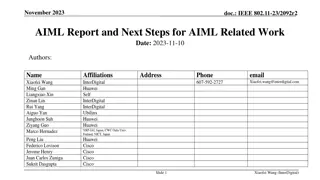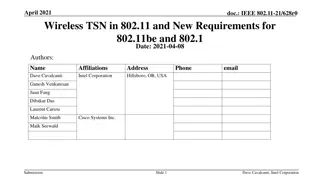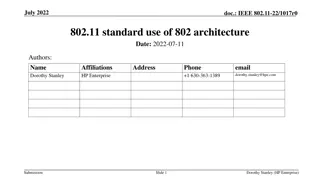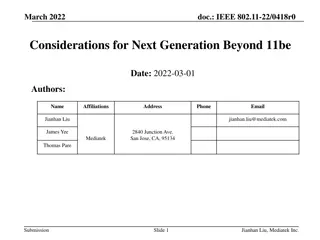Proposal to Add National Security and Emergency Preparedness Priority Access Feature in IEEE 802.11be Amendment
The document proposes integrating the National Security and Emergency Preparedness (NSEP) priority access feature into the IEEE 802.11be standard to ensure seamless NSEP service experience, particularly in Wi-Fi networks used as last-mile access. The NSEP priority feature at the MAC layer is independent of specific PHY dependencies, enhancing service providers' ability to deliver quality and priority services in Wi-Fi access networks, especially in conjunction with 5G services.
Download Presentation

Please find below an Image/Link to download the presentation.
The content on the website is provided AS IS for your information and personal use only. It may not be sold, licensed, or shared on other websites without obtaining consent from the author.If you encounter any issues during the download, it is possible that the publisher has removed the file from their server.
You are allowed to download the files provided on this website for personal or commercial use, subject to the condition that they are used lawfully. All files are the property of their respective owners.
The content on the website is provided AS IS for your information and personal use only. It may not be sold, licensed, or shared on other websites without obtaining consent from the author.
E N D
Presentation Transcript
April 2022 doc.: IEEE 802.11-22-0658/r0 Comment Resolution (CID#2319) CID # Comment Proposed Resolution/Approach Specify NSEP features in REVme. Background of NSEP and a proposal are included in this document. 2319 National Security and Emergency Preparedness (NSEP) priority access feature is introduced in .11be amendment. Within United States, National Security and Emergency Preparedness Priority Service is deployed over Cellular and Wireline networks. Many other countries have similar services as well. While many of the existing deployment infrastructure includes Wi-Fi as last mile access, it lacks the priority access support. Therefore, it is important that NSEP priority access is also supported (e.g.. when the service is offloaded to Wi-Fi access, in particular as a part to 5G services) in current deployment. This will help service providers to provide a seamless NSEP service experience to the users while maintaining the priority and quality of service in Wi-Fi access networks. The proposal is to add the NSEP priority feature in REVme. This is viable because NSEP priority access is a MAC layer feature with no specific PHY dependencies and no reliance on 11be-specific features (e.g., MLO). Submission Slide 1 Subir Das, Peraton Labs
April 2022 doc.: IEEE 802.11-22-0658/r0 Emergency Preparedness Communication Service (EPCS*): Background and Proposal Date: 2022-04-23 Authors: Name Subir Das John Wullert Affiliations Peraton Labs Address 150 Mt. Airy Road, Basking Ridge, New Jersey, 07920, USA 245 Murray Lane, Building 410 Washington, DC 20528-8510 Phone 908 748 2483 908 748 2687 732 898 8420 202 297 1817 703 307 4422 email (sdas, jwullert) @peratonlabs.com An Nguyen Frank Suraci DHS/CISA/ECD (an.p.nguyen, frank.suraci) @cisa.dhs.gov *NSEP is renamed as EPCS (Emergency Preparedness Communication Service) in IEEE 802.11be Submission Slide 2 Subir Das, Peraton Labs
April 2022 doc.: IEEE 802.11-22-0658/r0 Background: Priority Services* Emergency Telecommunications Service (ETS) specified in [ITU-T E.107]: A national service, providing priority telecommunications to the ETS authorized users in times of disaster and emergencies (e.g., floods, earthquakes, hurricanes, terrorist attacks) In United States, DHS/CISA/ECD Priority Telecommunications Services programs provide National Security and Emergency Preparedness (NS/EP) and public safety users the ability to communicate on telecommunications networks during times of congestion Government Emergency Telecommunications Service (GETS) Wireless Priority Service (WPS) Next Generation Network Priority Services (NGN Priority Services) Telecommunications Service Priority (TSP) Priority Service in other countries Blue Light Mobile service in Belgium, Mobile Crisis Communications service in the Czech Republic, Mobile Telecommunications Privileged Access Scheme in Great Britain, Disaster Priority Telephone ( ) in Japan, and Wireless Priority Service (WPS) in Australia, and Canada. * Priority Services differ from the citizen-to-authority type of Emergency Services (e.g. E911in the U.S.) the latter service being available to any user. Submission . Slide 3 Subir Das, Peraton Labs
April 2022 doc.: IEEE 802.11-22-0658/r0 Background NS/EP Communications Overview in United States PRESIDENT NATIONAL SECURITY LEADERSHIP Chief Executive Commander-In-Chief Head of State NATIONAL ESSENTIAL FUNCTIONS US POPULATION PARTICIPANTS INDUSTRY STATE & LOCAL ALLIES EMBASSIES INTEL Threat Assessment and Attack Warning C2 of Military Forces Military Mobilization Military Assist. To Civil Authorities Population Warning Utility Services Transportation Food/Essentials Distribution Worldwide Diplomacy Worldwide Intelligence Submission Slide 4 Subir Das, Peraton Labs
April 2022 doc.: IEEE 802.11-22-0658/r0 Background NS/EP Priority Services in the US NS/EP priority services are subscription based, operator controlled, enabled through global Standards, and are offered over commercial network infrastructure. Growing need for priority support over Wi-Fi access networks which is currently missing. GETS NGN PRIORITY WPS IP Networks Cell Phone Landline Phone Satellite Phone Priority Voice Core Operational: 2014 Wireless Access: 2017 Wireline Access: 2019 Operational since 1994 Operational since 2002 Calling Card service Accessible from a WPS subscribed phone of a participating carrier by dialing *272 + Destination Number Accessible from any domestic or international PSTN phone. Priority Data, Video and Information Services (e.g., Multimedia Priority Service (MPS) in 5G, Wi- Fi): Work in Progress Submission Slide 5 Subir Das, Peraton Labs
doc.: IEEE 802.11-22-0658/r0 NS/EP Priority Services over Wi-Fi Access Networks Use Case Disaster event occurs (e.g., Wildfire, Hurricane, Terrorist Attack) Network Infrastructure: Physical Damage and/or Congestion Overload Response requires coordination among field agents from federal, state, and local entities Command center established in nearby enterprise conference room Cellular service in conference room is poor/unavailable Field agents use enterprise s managed Wi-Fi access network for communications Wi-Fi becomes congested with competing traffic Field agents invoke NS/EP Priority Service on enterprise s Wi-Fi access network Wi-Fi priority access is enabled and field agents (authorized) obtain successful communications To support the Priority Services in Wi-Fi networks, Priority Access to the medium is required 6 Submission
April 2022 doc.: IEEE 802.11-22-0658/r0 Current Status EPCS in IEEE 802.11be Emergency Preparedness Communications Service (EPCS) features have been defined in IEEE 802.11be as an on-demand capability that allows access points (APs) to authorized non-access point STAs to communicate with a higher priority Enhanced priority for access to wireless channel The definition describes how service functions are negotiated with an MLD Submission Slide 7 Subir Das, Peraton Labs
April 2022 doc.: IEEE 802.11-22-0658/r0 Motivation for Introducing the Features in REVme To satisfy the growing need to support Priority Services features in the current deployment (where possible via software/firmware updates) The issue is that there no such technical specification exists today in the base IEEE 802.11 specification This talk describes a proposal for adding Priority Access capabilities within REVme so that the stakeholders can deploy the Service over current deployment Submission Slide 8 Subir Das, Peraton Labs
April 2022 doc.: IEEE 802.11-22-0658/r0 Key EPCS Features EPCS involves three primary features Advertisement: AP indicating support in Beacon/Probe Response and STA indicating support in Probe and (Re)Association Requests Enable/Teardown: AP or STA initiating process to turn priority functionality on or off Priority Access: STA makes use of dedicated EDCA parameters that provide priority in access to wireless channel Submission Slide 9 Subir Das, Peraton Labs
April 2022 doc.: IEEE 802.11-22-0658/r0 A Strawman Proposal to REVme in Support of EPCS The initial proposal may address the following sub-clauses in REVme 4.5 Overview of the services: Add sub-clause describing EPCS functionality 6.3 MLME SAP interface: Add sub-clauses for EPCA-specific services 9.6.3 QoS Action frame details: specify action frames to enable/tear down EPCS 11 MLME: Add sub-clause to specify behaviors necessary to support EPCS Subsequent proposal may address several other REVme sub-clauses* 3.1 Definitions and 3.4 Abbreviations and acronyms: define key EPCS terms 9.4.1.9 Status Code field: Add EPCS-specific status codes to Table 9-78 9.4.2.26 Extended Capabilities element: Add EPCS support element to Table 9-190 If the TG accepts adding the EPCS features, we can discuss and decide how to prioritize the effort and meet the REVme schedule * May find additional sub-clauses as we progress Submission Slide 10 Subir Das, Peraton Labs
April 2022 doc.: IEEE 802.11-22-0658/r0 Straw Poll #1 Do you support to incorporate Priority Access features into REVme? Y: N: A: Submission Slide 11 Subir Das, Peraton Labs
April 2022 doc.: IEEE 802.11-22-0658/r0 References [1] IEEE P802.11be /D1.5, Part 11: Wireless LAN Medium Access Control (MAC) and Physical Layer (PHY) Specifications, Amendment 8: Enhancements for extremely high throughput (EHT) , March 2022 Submission Slide 12 Subir Das, Peraton Labs























